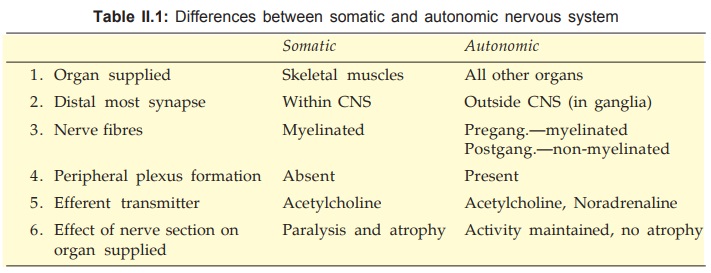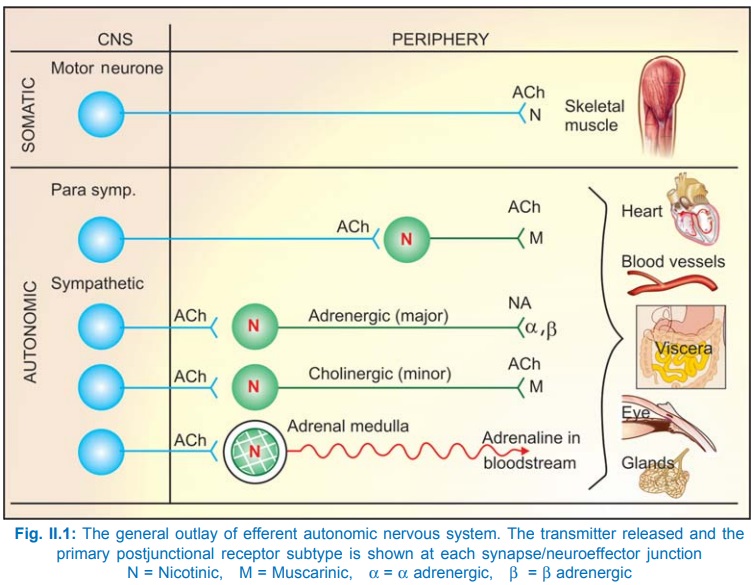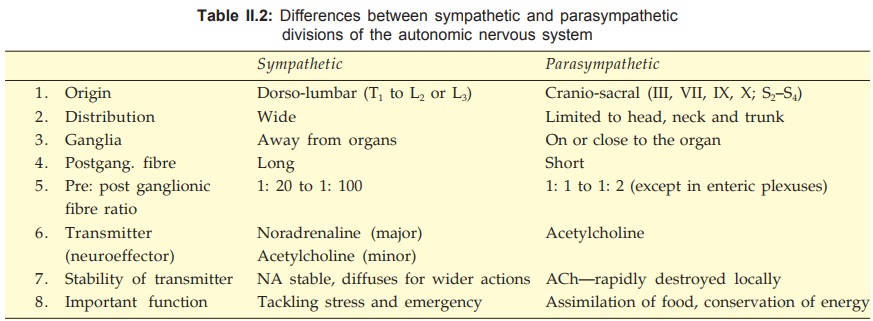Organization and Function
| Home | | Pharmacology |Chapter: Essential pharmacology : Autonomic Nervous System: General Considerations
The autonomic nervous system (ANS) functions largely below the level of consciousness and controls visceral functions.
ORGANIZATION AND FUNCTION
The autonomic nervous system (ANS) functions largely below the level of consciousness and controls visceral functions. The major differences between the somatic and autonomic nervous systems are given in Table II.1.

Like the somatic nervous system, the ANS consists of afferents, centre and efferents.
Autonomic Afferents
Most visceral nerves are mixed nerves and carry nonmyelinated visceral afferent fibres. The cell bodies of these afferent fibres are located in the dorsal root ganglion of spinal nerves and the sensory ganglia (e.g. nodose ganglion of vagus) of cranial nerves. They mediate visceral pain as well as cardiovascular, respiratory and other visceral reflexes.
Central Autonomic Connections
There are no exclusively autonomic areas in the CNS; considerable intermixing and integration of somatic and autonomic innervation occurs. The highest seat regulating autonomic functions is in the hypothalamus—posterior and lateral nuclei are primarily sympathetic while anterior and medial nuclei are primarily parasympathetic. Many autonomic centres (pupillary, vagal, respiratory, etc.) are located in the midbrain and the medulla in relation to the cranial nerves. The lateral column in the thoracic spinal cord contains cells which give rise to the sympathetic outflow.
Autonomic Efferents
The motor limb of the ANS is anatomically divided into sympathetic and parasympathetic. In general, these subdivisions are functionally antagonistic and most organs receive both sympathetic and parasympathetic innervation. The level of activity of innervated organ at a given moment is the algebraic sum of sympathetic and parasympathetic tone. However, refractory period of atrial fibres is decreased by sympathetic as well as parasympathetic influences. Most blood vessels, spleen, sweat glands and hair follicles receive only sympathetic, while ciliary muscle, gastric and pancreatic glands receive only parasympathetic innervation.
The enteric plexus of nerves receives inputs from both sympathetic and parasympathetic divisions, but in addition functions independently to integrate bowel movements as well as regulate secretion and absorption. As such, it has also been labelled as a distinct ‘enteric nervous system’.

The general layout of ANS is depicted in Fig. II.1 and the important differences between its two subdivisions are given in Table II.2

